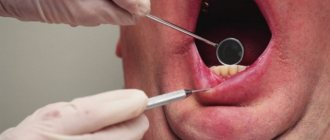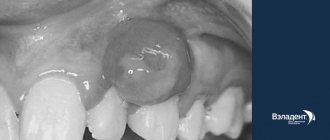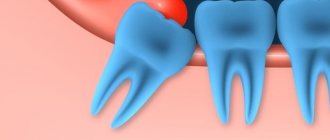Oral papillomas are benign neoplasms in the oral cavity that grow from epithelial cells. Papillomas are discovered during a dental examination and look like separate growing seals on a small stalk, they are painless and have a white or pale pink color.
This type of neoplasm in the oral cavity is diagnosed most often. About 60% of patients are women aged forty years, about 20% are teenagers of any gender. Often, adults experience the appearance of individual papillomas, while children may experience so-called papillomatosis (multiple papillomas). In half of the cases, papillomas are localized on the mucous membrane of the tongue.
Papilloma in the mouth: causes of appearance
The most common cause of this type of tumor is the human papillomavirus (HPV).
Factors that provoke the appearance of papillomas in the oral cavity are, for example, constant microdamage to the cheeks and tongue. A relatively small damage is enough for viral particles to penetrate inside and trigger the formation of papilloma. In children, the provoking factor is a too short frenulum of the tongue - the lower incisors injure it, creating a gateway for infection.
When analyzing papilloma under a microscope, it can be noted that this neoplasm is a tumor, which consists of many layers of epithelial tissue, which in some places has become significantly keratinized. In some areas, traces of the appearance of a focus of inflammatory infection can be noted.
Diagnosis of HPV
Currently, there are no simple solutions to diagnosing human papillomavirus. The polymerase chain reaction (PCR) method is considered the most effective.
In PCR testing, doctors take a small piece of DNA from mucosal cells and amplify it, creating numerous identical copies. Having many copies of DNA allows doctors to detect ultra-small amounts of abnormal or viral DNA.
In rare cases where there are lesions in the mouth, HPV can only be diagnosed by a doctor based on a physical examination.
How to distinguish condyloma from papilloma
Many patients confuse papillomas with condylomas. In order not to confuse the two epithelial formations with each other, you need to know what papillomas look like and what condylomas are.
The main similarity between the two neoplasms is the cause of their occurrence – the HPV virus. The differences between papilloma and condyloma include:
| Papilloma | Condyloma |
| · caused by HPV types 1, 2, 3, 4, or 10; · almost never becomes malignant (except for the influence of certain factors); · localization site – the whole body and oral mucosa; · located singly; · capable of disappearing on their own. | · caused by HPV types 6 or 11; · capable of becoming malignant; · the main place of localization is the genitals; · located in a group with further fusion into one spot; · surgical treatment is mandatory. |
Which doctor should I contact for papillomas in the mouth?
Any diseases and defects associated with the oral cavity are primarily dealt with by an otolaryngologist. In children, this function can be performed by an ordinary pediatrician, but this is justified only if the problem has not progressed. He first examines the mucous membranes, tongue, tonsils and other organs located in this area.
Visiting an otolaryngologist for oral papilloma
When trying to understand which doctor to go to with papilloma in the mouth, it must be said that the ENT examines a person for growth, including on the vocal cords and lingual tonsil, in the nasal cavity, etc. If it is not very deep, then a visual inspection using a special mirror is usually sufficient. Otherwise, a more thorough diagnosis is required. Here can be assigned:
- Laryngoscopy . It can be indirect, performed in an outpatient setting, and direct (deep), requiring general anesthesia and placing the person in a hospital. This diagnostic technique is relevant only if there is a suspicion of a growth at the root of the tongue, on the vocal cords and in other hard-to-reach locations. This procedure for papilloma in the mouth can be carried out by the ENT specialist himself.
- Videoendoscopy . This technique involves inserting into the oral cavity, sometimes through the nose, a thin tube with a camera attached to the end to study the condition of the mucous membrane. This is an unpleasant and painful procedure, so it is prescribed only when indicated and if a biopsy is necessary. It is performed under local anesthesia.
- Radiography . As the name implies, this is nothing more than the usual “photography” of suspicious areas using special rays. If small doses of radiation are used, this procedure does not pose a health hazard, but it is still often not recommended. This method should be excluded during pregnancy, as it can negatively affect its course. A doctor with an ENT specialization does not perform this procedure for oral papilloma on his own; he refers the patient to other specialists.
If a growth is detected and malignancy is suspected, the ENT specialist must take a sample and send it for histological examination to exclude oncology.
Visiting the dentist for oral papilloma
Along with otolaryngology, this is another branch of medicine that studies diseases of the oral cavity. In other countries, especially in the United States, this specialist is also called a dentist or dentist. These doctors are not directly related to papillomas, but their consultation is relevant, for example, when growths are located near molars. This can provoke discomfort and inflammation of the gums, which is definitely within the competence of such a doctor.
If you are not yet sure which doctor to go to with papilloma in the mouth, but are going to the dentist in the near future, be sure to tell him about your problem. He, just like an ENT specialist, will conduct a visual examination of the mucous membranes for the purpose of diagnosis, but without examining the entire larynx in detail. Its task is to evaluate the surface areas and determine whether the growth is the result of any dental pathologies. For this purpose, a special mirror and x-ray can be used, and a 3D study can be carried out. The latter is the most informative and accurate in indications.
Consultation with a virologist for oral papilloma
As is clear from the specialization, the tasks of this doctor include the study of various viruses, as well as the diagnosis, treatment and prevention of diseases that they cause. Since papillomas arise precisely as a result of HPV activity, the search for effective methods to combat them lies partly in the area of responsibility of a doctor with this profile.
This is interesting: Why periodontitis appears in childhood: how to recognize and how to treat
If you want to find out which doctor treats papillomas in the mouth, you must not forget that it is the same virologist who helps determine which strain of the virus provoked its growth. He can participate in the analysis of blood and excrement to identify the causative agent of the disease. Most often, it is necessary to take referrals from him for such research.
The role of the virologist is enormous because without suppressing the activity of the papilloma virus, it is impossible to talk about the possibility of removing the formation caused by its activity. He can suggest suitable preventative measures, recommend good antiviral agents and medications for treatment.
Consultation with an oncologist for oral papilloma
Such consultation is justified if there is suspicion of a malignant process. Usually, an oncologist is contacted if there is a sudden change in the shape, color, structure of the formation, if it sharply increases in size, if there is discomfort, redness and itching, or if there is bleeding.
Consultation with this doctor becomes especially important for oral papilloma caused by oncogenic types of the virus. Scientists count more than 18 such strains, some of them are less dangerous, while others pose a serious threat to health, including the oral cavity.
The oncologist’s task is, together with a virologist, to determine how serious the type of HPV that has affected a person is, and to carefully examine the formation for integrity and pathological changes. If necessary, he must select a sample and submit it for examination to exclude malignancy.
Consultation with an immunologist for oral papilloma
This specialist works with people whose papilloma is the result of problems with the immune system. A visit to him when a growth forms in the mouth is mandatory, since such failures occur in almost every person.
At the appointment, the doctor collects the patient’s medical history and refers him to the necessary tests to identify the causes of the growth. To determine the culprit for the growth of papilloma in the mouth, the immunologist gives a referral for a general and clinical blood test, sugar testing, rheumatoid tests and other studies. It is he who has the right to prescribe effective stimulants of the immune system and control the progress of treatment.
The problem is that many hospitals simply do not have an immunologist on staff. Therefore, his responsibilities are often transferred to the shoulders of the same virologist, infectious disease specialist or ordinary therapist.
Examination by a dermatologist for oral papilloma
When looking for an answer to the question of which doctor to contact for oral papilloma, do not forget that a dermatologist deals only with the diagnosis and treatment of skin-related diseases. But in recent years, his tasks have also included examining patients with complaints of growths on the mucous membranes, including in the oral cavity.
During the consultation, the doctor must examine the formation, visually assess its condition and, if necessary, scrape it. In case of papilloma in the mouth, the dermatologist is obliged to exclude violation of the integrity of the growth, its bleeding, inflammation and redness. He, like other specialists, can give directions for tests necessary to clarify the causes of the problem.
Finding such a doctor is not easy, since at the end of residency, graduates choose more universal specialties, for example, dermatologist-oncologist. It will be even better to contact him, this will reduce the time for diagnosis.
To summarize, it must be said that the easiest way would be to first contact a general practitioner or family doctor. He will be able to tell you exactly which doctor removes papillomas in the mouth and what examinations you need to undergo before this. Otherwise, there is a possibility of spending a lot of money, time and nerves, postponing the solution of the problem for a long time.
Papillomas on the oral mucosa occur against a background of weakened immunity. Such growths are single and multiple in nature.
Classification of oral papillomas
Based on the number and concentration of neoplasms, oral papilloma is differentiated from papillomatosis – a massive accumulation of neoplasms in one place.
According to their origin, papillomas are divided into the following types:
- Traumatic (reactive) papilloma. May appear after traumatic effects of a mechanical, chemical or temperature nature. A distinctive and characteristic feature of reactive type oral papilloma is that their growth stops immediately after the irritant that caused them is eliminated.
- True (neoplastic) papilloma. This type of papilloma begins to develop after the mechanism of cell division, growth, and differentiation is disrupted. In most cases, this type of papillomas appears in the distal part of the cheek, in the area located behind the molars and in the area of the pterygomandibular fold.
- Viral papilloma of the oral cavity. May appear after the patient has been infected with the human papillomavirus. This type of infection occurs through direct contact with a carrier of the virus. When the integrity of the oral mucosa is compromised (for example, due to microtrauma), a path for infection appears.
Papillomas on the gums of a child
The reasons for the formation of benign growths on the gums in children are the same as in adults. Children aged 6-12 years are at risk of contracting HPV. This is due to extreme curiosity, poor hygiene, lack of stress tolerance and reduced immunity.
The places where papillomas form in childhood are as follows:
- gum;
- language;
- red border of lips;
- larynx;
- throat.
Complaints in a child with HPV may indicate pain and discomfort during eating and breathing. The clinical picture is similar to the course of the disease in an adult.
Treatment of oral papillomas
Diagnosis of this disease includes a collection of the patient’s medical history, as well as a thorough histological examination of removed papillomas.
Treatment of papillomas is only surgical. The neoplasm is excised down to the borders of healthy tissue. Techniques such as electrocoagulation, cryosurgery, sclerotherapy and others are rarely used, since as a result of their implementation it is impossible to conduct a histological analysis of the papilloma removed to the base.
If a large accumulation of papillomatous neoplasms is detected, a combined technique is used: a scalpel is used to dissect the largest number of papillomas accumulated in one place, and single papillomas are removed using electrocoagulation.
If oral papillomas have a viral etiology, antiviral and immunomodulatory therapy is prescribed along with surgical intervention to prevent relapses.
Depending on the etiology of the disease, relapses may occur with greater or lesser probability. So, if there is a human papillomavirus in the body, the risk of papillomas returning after surgery is quite high.











